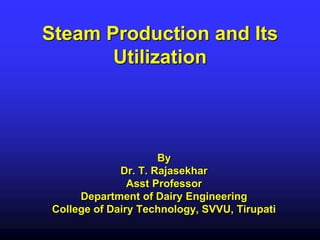STEAM_AND_ITS_USE.pptx
•Als PPTX, PDF herunterladen•
0 gefällt mir•14 views
Steam production and its utilization
Melden
Teilen
Melden
Teilen

Empfohlen
young call girls in Green Park🔝 9953056974 🔝 escort Service

young call girls in Green Park🔝 9953056974 🔝 escort Service9953056974 Low Rate Call Girls In Saket, Delhi NCR
Weitere ähnliche Inhalte
Ähnlich wie STEAM_AND_ITS_USE.pptx
Ähnlich wie STEAM_AND_ITS_USE.pptx (20)
Ppt on thremal power station surtgarh by ashok khoja

Ppt on thremal power station surtgarh by ashok khoja
Kürzlich hochgeladen
young call girls in Green Park🔝 9953056974 🔝 escort Service

young call girls in Green Park🔝 9953056974 🔝 escort Service9953056974 Low Rate Call Girls In Saket, Delhi NCR
9953056974 Call Girls In South Ex, Escorts (Delhi) NCR.pdf

9953056974 Call Girls In South Ex, Escorts (Delhi) NCR.pdf9953056974 Low Rate Call Girls In Saket, Delhi NCR
Kürzlich hochgeladen (20)
young call girls in Green Park🔝 9953056974 🔝 escort Service

young call girls in Green Park🔝 9953056974 🔝 escort Service
Study on Air-Water & Water-Water Heat Exchange in a Finned Tube Exchanger

Study on Air-Water & Water-Water Heat Exchange in a Finned Tube Exchanger
Gurgaon ✡️9711147426✨Call In girls Gurgaon Sector 51 escort service

Gurgaon ✡️9711147426✨Call In girls Gurgaon Sector 51 escort service
Comparative Analysis of Text Summarization Techniques

Comparative Analysis of Text Summarization Techniques
Exploring_Network_Security_with_JA3_by_Rakesh Seal.pptx

Exploring_Network_Security_with_JA3_by_Rakesh Seal.pptx
9953056974 Call Girls In South Ex, Escorts (Delhi) NCR.pdf

9953056974 Call Girls In South Ex, Escorts (Delhi) NCR.pdf
Call Girls Narol 7397865700 Independent Call Girls

Call Girls Narol 7397865700 Independent Call Girls
complete construction, environmental and economics information of biomass com...

complete construction, environmental and economics information of biomass com...
Biology for Computer Engineers Course Handout.pptx

Biology for Computer Engineers Course Handout.pptx
Risk Assessment For Installation of Drainage Pipes.pdf

Risk Assessment For Installation of Drainage Pipes.pdf
Call Girls Delhi {Jodhpur} 9711199012 high profile service

Call Girls Delhi {Jodhpur} 9711199012 high profile service
Introduction-To-Agricultural-Surveillance-Rover.pptx

Introduction-To-Agricultural-Surveillance-Rover.pptx
Gfe Mayur Vihar Call Girls Service WhatsApp -> 9999965857 Available 24x7 ^ De...

Gfe Mayur Vihar Call Girls Service WhatsApp -> 9999965857 Available 24x7 ^ De...
Decoding Kotlin - Your guide to solving the mysterious in Kotlin.pptx

Decoding Kotlin - Your guide to solving the mysterious in Kotlin.pptx
An introduction to Semiconductor and its types.pptx

An introduction to Semiconductor and its types.pptx
Sachpazis Costas: Geotechnical Engineering: A student's Perspective Introduction

Sachpazis Costas: Geotechnical Engineering: A student's Perspective Introduction
STEAM_AND_ITS_USE.pptx
- 1. Steam Production and Its Utilization By Dr. T. Rajasekhar Asst Professor Department of Dairy Engineering College of Dairy Technology, SVVU, Tirupati
- 2. What is Steam? As the temperature increases and the water approaches its boiling condition, some molecules attain enough kinetic energy to reach velocities that allow them to momentarily escape from the liquid into the space above the surface, before falling back into the liquid. When the number of molecules leaving the liquid surface is more than those re-entering, the water freely evaporates. Steam should be available at the point of use: In the correct quantity. At the correct temperature and pressure. Free from air and incondensable gases. Clean. Dry.
- 3. Steam Production To produce steam Boiler is used. A number of different boiler types have been developed to suit the various steam applications. The objectives of a boiler are: • To release the energy in the fuel as efficiently as possible. • To transfer the released energy to the water, and to generate steam as efficiently as possible. • To separate the steam from the water ready for export to the plant, where the energy can be transferred to the process as efficiently as possible.
- 5. Vertical Tube Packaged Boiler
- 6. Examples for Steam Heating Possible layout of coils in a rectangular tank Side hung coils A conventional jacketed vessel
- 7. Measurement of Steam Consumption
- 8. Arrangement of steam supply for consumers of High Pressure and Low Pressure
- 9. Steam Distribution in a Dairy Plant